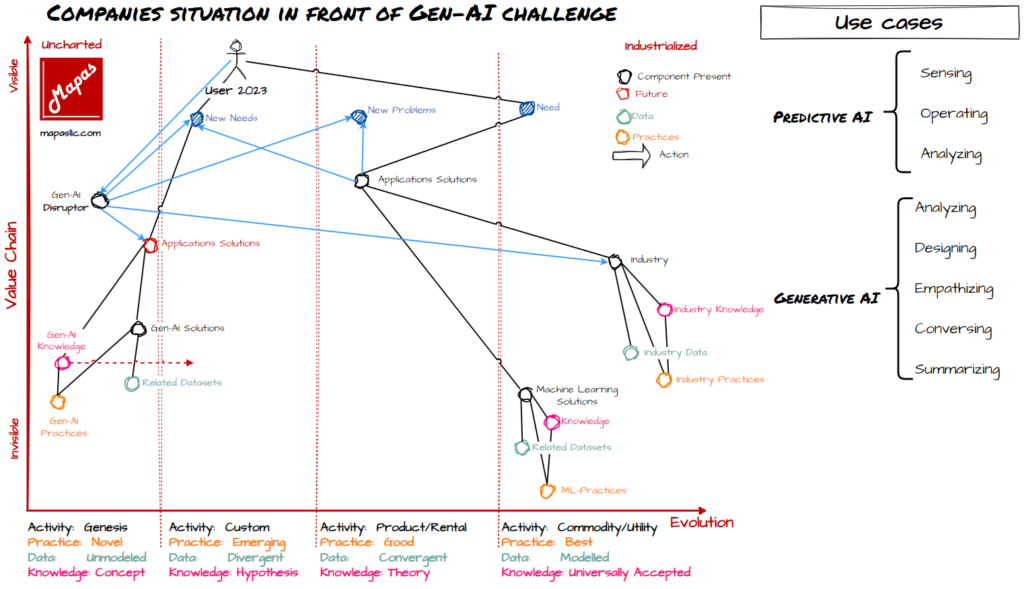Background
Technological disruption is something that happens from time to time. Right now all people is focused on Generative-AI and many people seem to be lost looking at what is going to happen.
We don’t really know, accept the uncertainty and stop doing linear correlations with simplistic things as “Gen-AI is going to improve the cost of how we do X task”.
The discovery of new use cases is an ongoing work and it depends how you are well positioned by design and by attitude what significantly is a competitive advantage in these cases.
Let’s start with the basis
Despite everybody has in mind what a use case is, I would like to give some definitions about the concepts we are going to use:
- Use case = a delta that needs to be proven (feasibility, market fit, etc).
- Deltas = gap that provides value to the value chain.
- Disruptor = Generative AI, Internet, plastic, penicillin…
- Co-evolution of practices: combination of well known practices, industry experience to dig into the potential use cases that could emerge.
“Power is nothing without control” was the slogan of a Pirelli’s advertisement in the 90s. I have slightly changed it.

For the map, I’m going to combine the different types of concepts you can draw in a Wardley Map. That’s the reason you will see many colours on the map. It’s done on purpose because technological disruption without the right practices is like “Power is nothing without control“.
This is what you will see in the x-axis of the map:

With this, I think we are ready for starting draw the idea.
What are the basis to be competitive in a marketplace?
This is a very broad question that I will try to clarify more. The anchor in this case is the client (user), but all will rotate around the concept of “use case”.
To be competitive in a marketplace you need many things, the first one is to satisfy a need the market and some clients potentially have: the delta. All companies are looking for deltas that satisfy client’s needs. These deltas have their own evolution: the show up, they gain presence, they are generally accepted and they disappear.
Start-ups are young organizations trying to find that delta.
How am I in a position to find a delta? Through different types of experience (first pipeline of the map). All of them are relevant:
- Industry experience: without this you have no context.
- Understand complexity: without understanding how things work in the industry you cannot evolve towards next stage.
- Disruptor experience: you have to start taming the new animal in the zoo (that’s the reason many companies are creating innovation projects around Gen-AI).
The delta is there, it’s in the air, but nobody sees it. In the map is right below experience. The reason is that a client first will recognize your position in the market, then it will evaluate your position to solve new problems.
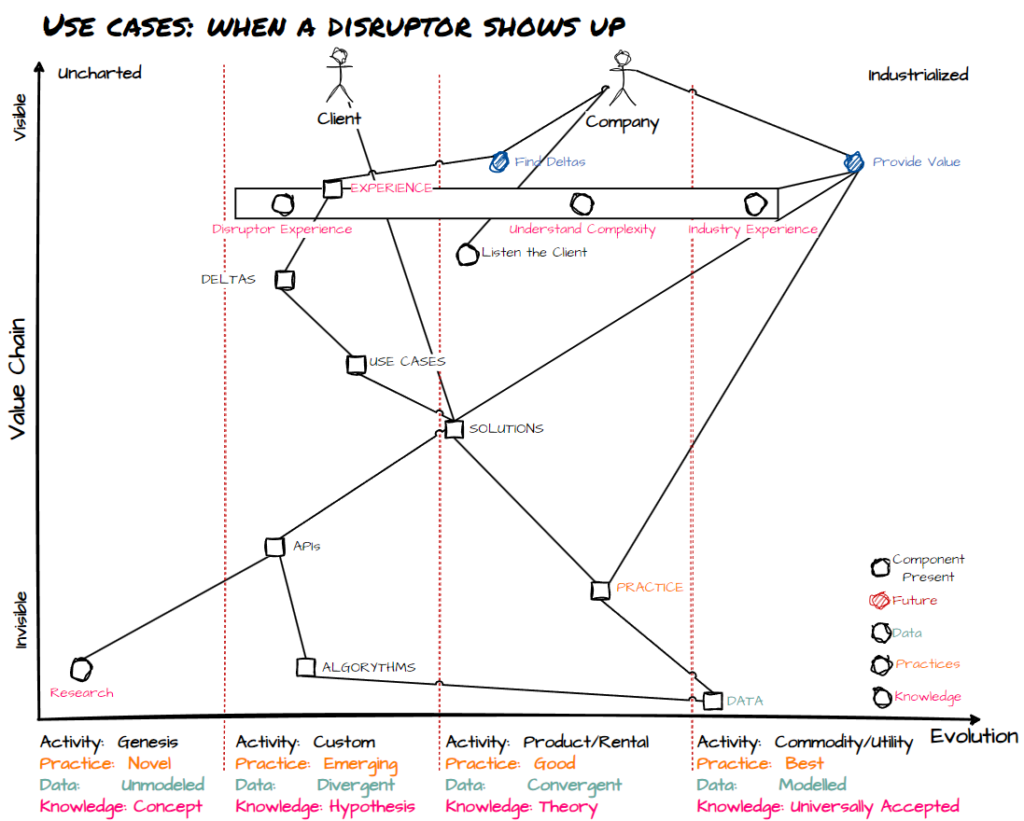
Delta -> use cases -> solutions
The next 3 elements of the map (delta, use cases and solutions) is the area of the map where many things happen. Here I would like the reader differentiate between these 2 well known concepts:
- Product solution fit: find the fit between the user need and the product.
- Market product fit: having a product that solves a problem for a viable market.
In this stage we are right before product solution fit stage: we are trying to find that gap that is still not found, and in this case not under stable conditions, we are in front of a disruptor that can shake all.
In this stage is where the major headache is right now and it is due to the appearance of the technological disruption.
Before to do that I would like to expand the small pipelines (components marked with small squares) with more information, to add more context to the disruptor I will introduce later:
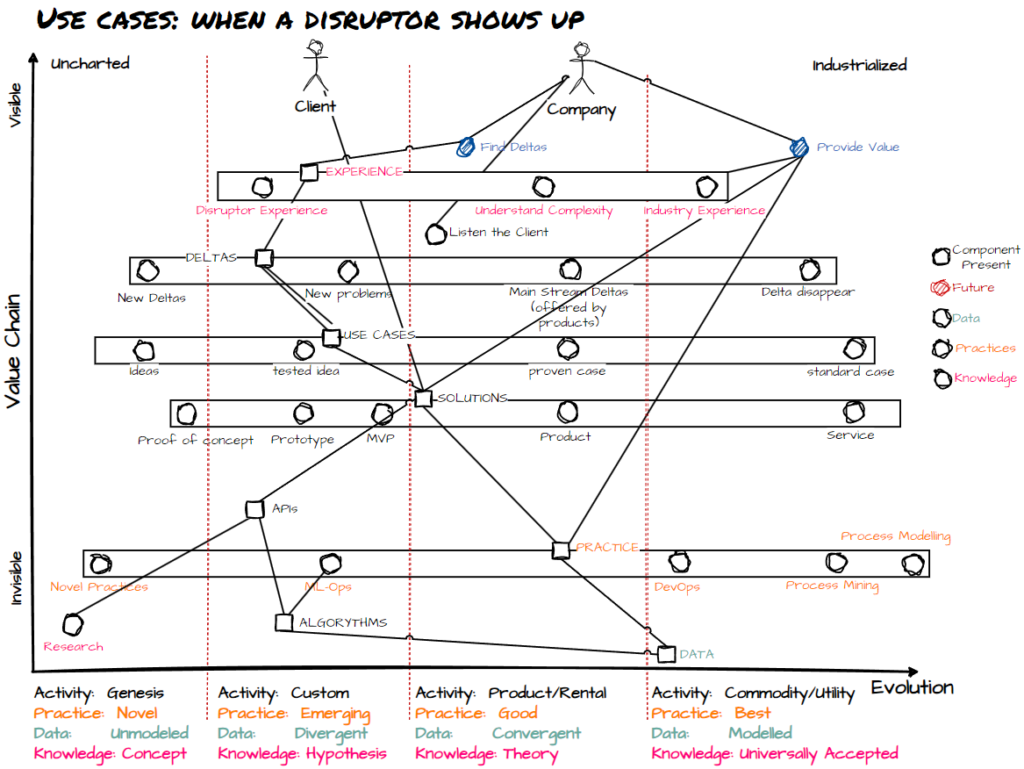
The basic division I have done in the pipelines try to show some type of evolution between them.
What happens when a disruptor appears?
What happens are the general perceptions that are described in the properties table built by Simon Wardley:
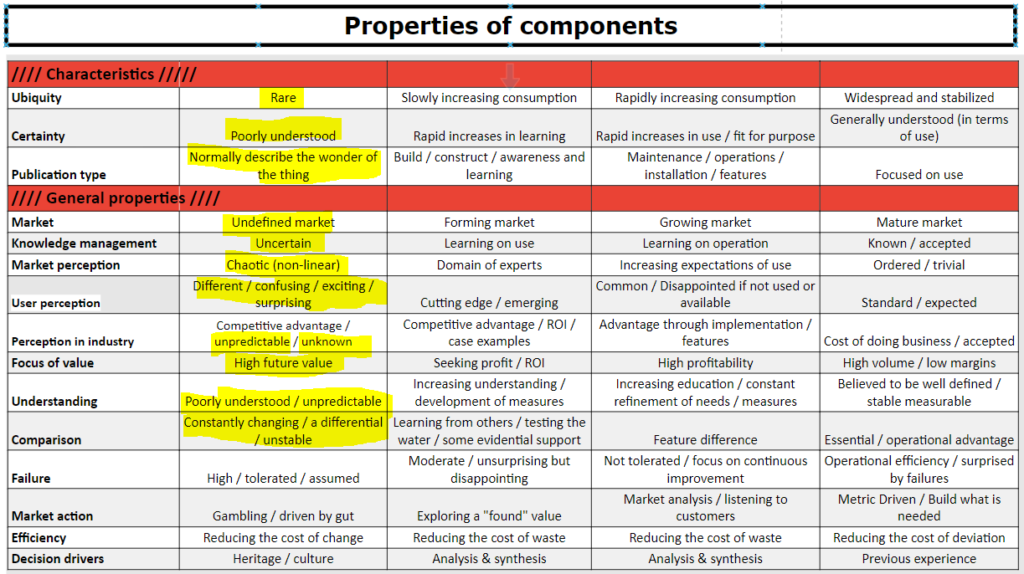
All seem to be apparently impacted by the disruptor, in this case “Gen-AI”.
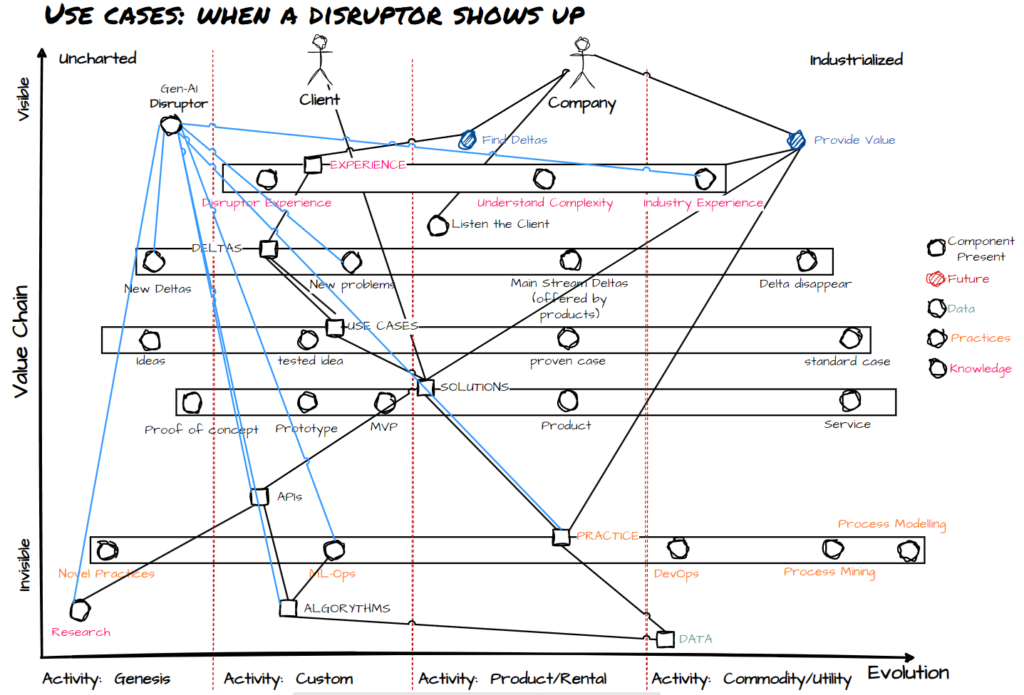
Reviewing some of the connections:
- Industry knowledge is challenged: what new things can we know from a different industry? how fast can we learn from another industry?
- New problems show up: how many people have hear about “hallucination” in computers space before LLMs?
- New solutions show up, and other solutions lose value or are too costly in comparison to the construction of solutions with the support of the disruptor.
- Machine Learning Ops: a practice that is being accelerated and the appearance of LLMs is making many people are willing to learn from it, and the practice itself is evolving to attend the new requirements coming from this new type of ML.
- Algorithms: the use of the available LLMs layer is making the appearance of new layers of abstraction and the evolution of many existing code that is trying to get advantage of the disruptor.
- Research: many new areas of research is going to happen in the near future.
So, where the heck can I start with?
Well, this is an article where I’m not working on a specific context, so I will focus on understanding well the disruptor and how it’s evolving. In this blog you can find many articles about LLMs and players doing things in the area. This should orient you on what’s coming and enabling you with your other experiences to dig into the identification of new deltas, construction of new use cases, etc.
I will just review a couple of perspectives on Generative AI. That’s not enough but it’s a starting.
Autonomous systems
Right now majority of solutions being built are based on the “Human in the loop” type of solution. This is where almost everybody is looking for. I personally would look for deltas in spaces where other systems like “human in the loop for Exceptions” and “Human on the loop”.
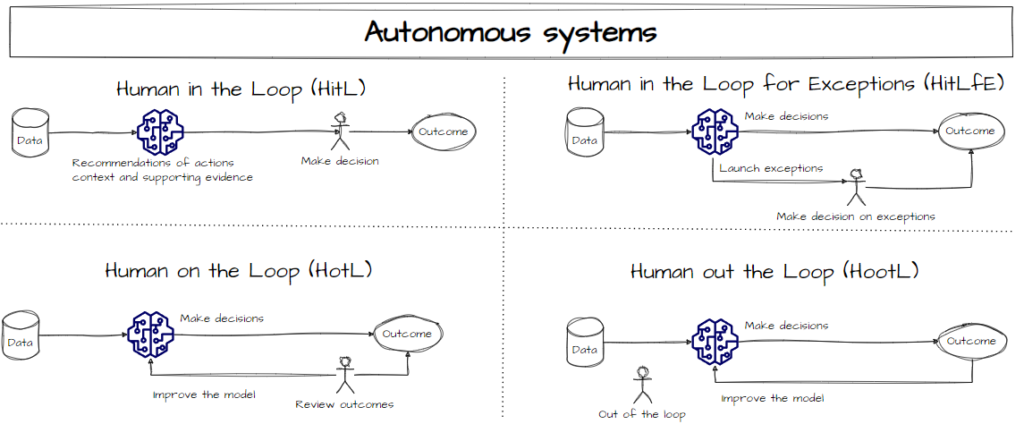
New types of use cases
Look at this table:

You first have to understand the basis where Generative AI helps, and separate from other type of Machine Learning areas. When I read or hear about people building data analysis solutions based on Generative AI, in the majority of the cases I identify as something you can do with predictive AI. Only if there’s a huge cost reduction opportunity there’s a reason to build in that way.
Designing, empathizing, conversing, summarizing… these are the areas where to focus.
Summarizing is the probably the more understandable area where you can work. For instance: when you are learning anything new, you can take relevant documentation and ask a prompt solution to give you summaries by section and increase the speed of learning. Ok, now translate that to a client need.
Data, data and more data
The disruptor uses data: no data, no generative-AI solution. By that reason I think that companies providing data services are going to increase their activities a lot.
What I mean is that around the construction of solutions, there are adjacent areas that as “data” are going to be positively affected by the disruptor.
Co-evolution of practice and reduction of barriers to entry
Co-evolution of practice is a climatic pattern from Wardley Mapping. It refers to the phenomenon where practices, methods, or activities evolve in tandem with the components or products they support or are associated with.
I would pay a lot of attention about how existing practices evolve. We all recognize that ML-Ops will evolve a lot with the support of Gen-AI, but what about Logistics best practices, DevOps, Human resources processes, financial analysis practices, etc.? Sooner or later they are going to change.
Simon built this table below.
- Everybody is looking at “existing trends” but if you just do it you are part of the herd (sorry, you are not innovating, you are just consuming biased information from advisory firms that have no clue about what’s happening).
- If you have a technological competitive advantage in Genesis, and you are convinced about it: Go for it!! But take into account 2 things:
- first, here is where majority of people are working on, and they are all passing away.
- second, the main reason is that they are not understanding that the major LLMs providers are using ILC gameplay (sorry another large article, but an useful one).
- I would focus on co-evolution of practice, combined with your experience on a competitive landscape and your industry knowledge. I would start looking there.
- Second area where I would investigate is on “reducing barriers to entry”: the disruptor is going to reduce a lot of barriers to entry. Analyse them in your context, protect your company understanding the changes that are coming, and attack adjacent spaces where you find that you can quickly conquer new positions. Competitors have usually poor situational awareness, get advantage of it.
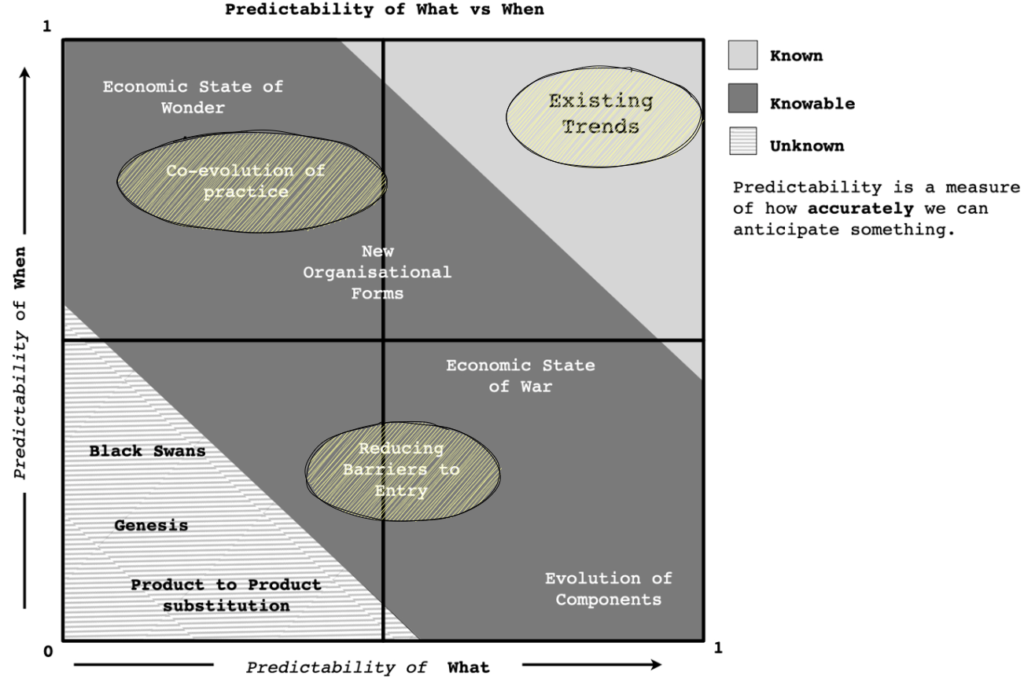
Takeaways
When dealing with new disruptors you have to take into account many things and ponderate properly the impact of the disruptor.
Orient yourself about how it impacts you, where It impacts you and then start doing decisions towards discovery of deltas.
I have used Wardley Maps to show what I consider relevant components in the evolution of the different industries. I have done with some clients a concrete exercise using this approach and enabling orientation using some of these maps. The exercise changes a lot depending on what your landscape is.
If you think this helped you, use it. If you think you would need some help, get in touch with me.
